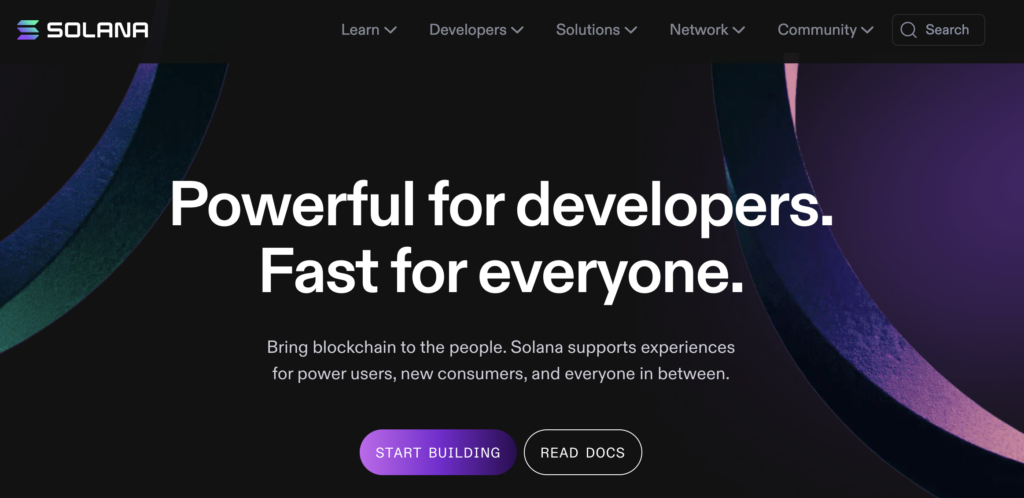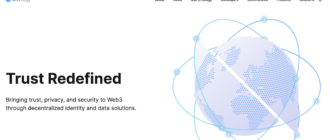Solana represents a significant breakthrough in blockchain technology, focusing on high throughput and low latency. Its primary aim is to provide a scalable and efficient platform for decentralized applications (dApps) and to support a global user base without compromising security or decentralization.

History of the Project
Solana was founded in 2017 by Anatoly Yakovenko, who brought his experience from Qualcomm to address the limitations in throughput and scalability faced by earlier blockchain technologies. Yakovenko introduced a new timekeeping technique within distributed networks called Proof of History (PoH), significantly enhancing the performance capabilities of the Solana blockchain. The project quickly gathered a robust team of engineers from top companies like Google, Apple, and Intel, driven by a shared vision of a high-performance blockchain. Over the years, Solana has marked several milestones, such as launching its mainnet beta in March 2020 and forming partnerships with various firms in the crypto space to expand its ecosystem.
What is Solana?
Solana is a high-performance cryptocurrency blockchain that supports smart contracts and decentralized applications. It is designed to solve the scalability issues of its predecessors by enabling higher transaction speeds without sacrificing security. Solana aims to serve both small-time users and enterprise customers by providing a reliable and efficient platform.
How Solana Works?
Solana’s architectural design uniquely addresses the limitations seen in earlier blockchain systems, primarily through innovations that allow it to achieve high throughput and low latency. Here are the key technologies underpinning the Solana project and their specific roles:
Blockchain Architecture
Solana’s blockchain architecture is revolutionary in its integration of a novel timekeeping mechanism called Proof of History (PoH). Unlike traditional blockchains that require massive amounts of computational power to maintain consensus, PoH allows nodes to have a cryptographic timestamp for each transaction, proving when events occur relative to one another. This feature is crucial for enhancing throughput as it reduces the overhead needed to coordinate between nodes, enabling the network to process tens of thousands of transactions per second.
Consensus Mechanism
In tandem with PoH, Solana employs the Proof of Stake (PoS) consensus mechanism. PoS in Solana not only secures the network but also complements the PoH by finalizing the order of blocks that are already timestamped, thus conserving energy and increasing transaction processing efficiency. This dual mechanism significantly lowers the likelihood of forks within the blockchain, ensuring a more stable and secure network.
Unique Technologies and Innovations
Turbine
A key differentiator for Solana is its Turbine protocol, which breaks data into smaller packets for transmission. This technology facilitates quicker block propagation, reducing the bandwidth load on validators and improving the scalability of the network.
Sealevel
Sealevel is another groundbreaking technology that Solana introduces. It is a parallelized transaction processing engine that allows Solana to scale horizontally across GPUs and SSDs. This means multiple smart contracts can run in parallel, significantly boosting the network’s capacity to handle simultaneous transactions and interactions.
Gulf Stream
Solana’s Gulf Stream protocol pushes transactions to the edge of the network before they are finalized, allowing validators to execute them ahead of their inclusion in the blockchain. This anticipatory execution reduces confirmation times and the memory load on validators, which is vital for maintaining high performance as the network scales.
Cloudbreak
Cloudbreak is Solana’s horizontally scalable accounts database. It organizes data in a way that enables simultaneous reads and writes across the network, solving a common bottleneck in distributed ledger technologies.
Distinction from Other Projects
Unlike many blockchain networks that struggle with scalability and speed, Solana’s combination of PoH and PoS along with its unique technological suite—Turbine, Sealevel, Gulf Stream, and Cloudbreak—enables an unprecedented transaction throughput while maintaining decentralization. These innovations address not only the performance issues but also the broader challenge of network efficiency, making Solana a standout project in the blockchain space.
The coherent integration of these technologies makes Solana distinctively capable of supporting large-scale decentralized applications, establishing it as a robust foundation for a new wave of blockchain adoption.
Tokenomics of Solana
Nature of SOL: Token or Coin?
SOL is the native cryptocurrency of the Solana blockchain. In the context of its ecosystem, SOL acts as a coin rather than just a token, as it is used as the primary currency within the network for transaction fees, staking, and governance, ensuring the operational integrity and security of the platform.
Emission Model and Supply Dynamics
Solana’s emission model is designed to encourage long-term security and network participation. Initially, SOL started with an inflationary model where the total supply increases over time. The inflation rate started at 8% per year and is designed to decrease by 15% annually until it reaches a long-term stable inflation rate of 1.5% per year. This approach aims to balance new supply entering the system with the increasing adoption and demand, while also compensating validators fairly for their efforts in securing the network.
Staking and Validator Rewards
Staking is a critical component of the SOL economy. SOL holders can stake their coins with validators, who process transactions and run the network. Validators and delegators earn rewards from the inflationary issuance of SOL, based on the amount they stake and the overall inflation rate. This staking reward mechanism incentivizes the holders to participate actively in network security, making the Solana blockchain more robust and decentralized.
SOL’s Role in Transaction Fees and Governance
Transaction fees on Solana are paid in SOL, which helps regulate the demand for the coin and offset the inflationary supply increases. These fees are used to compensate validators for the computational resources needed to support the network’s operation. Furthermore, SOL is used in governance, where holders can vote on future upgrades and changes to the blockchain protocols, ensuring a democratic and user-driven development path.
Market Dynamics and Price
SOL’s price is subject to the typical market dynamics of supply and demand, influenced by the broader cryptocurrency market trends, investor sentiment, and Solana’s adoption in dApps and decentralized services. Since its launch, SOL has experienced significant price volatility, a common characteristic in cryptocurrency markets, reflecting changes in investor expectations and shifts in the broader economic environment.
The detailed structuring of Solana’s tokenomics, from its inflationary supply model to its staking incentives, is carefully calibrated to maintain the long-term viability and security of the network while fostering an active community of users and validators. This ensures that SOL remains integral not only as a utility coin within the Solana ecosystem but also as a valuable asset in the portfolios of crypto investors.
Where to Buy the SOL Coin?
SOL, as a widely recognized cryptocurrency, is available for purchase on several major exchanges, ensuring that potential buyers have multiple platforms to choose from, depending on their geographic location and preference for trading features. Here are some of the prominent exchanges where SOL can be acquired:
- Binance: Known for its high liquidity, Binance offers SOL trading with multiple pairings, including against major cryptocurrencies and fiat currencies. Binance also provides features like futures and margin trading for SOL.
- HTX (formerly Huobi): HTX provides a reliable platform with a user-friendly interface for buying and selling SOL. It supports various trading options, including spot and derivatives trading.
- MEXC: This exchange is known for offering a wide range of cryptocurrencies, including SOL. MEXC provides options for spot trading and features like staking directly from the exchange platform.
- Bybit: Bybit is primarily known for derivatives trading but also offers spot markets where SOL can be traded. It is praised for its advanced trading features and competitive trading fees.
- KuCoin: KuCoin offers SOL trading and is renowned for its easy-to-use platform that caters to both novice and experienced traders. KuCoin also supports staking and lending services for SOL.
- Bitfinex: Offering a suite of order types and trading tools, Bitfinex is a solid choice for trading SOL, particularly for those looking for advanced trading capabilities and high liquidity.
Where to Store the SOL Coin?
When it comes to storing SOL, users have several options, each providing different levels of security and functionality. Here’s a guide to choosing the right wallet:
- Solana’s Official Wallets: Solana offers several official wallet solutions designed specifically for SOL, ensuring full compatibility and security.
- Phantom Wallet: This is a popular choice among Solana users, offering a user-friendly browser extension that integrates seamlessly with most web-based dApps on the Solana blockchain. Phantom allows for staking SOL directly from the wallet.
- Solflare Wallet: Another comprehensive option, Solflare is available as a web wallet and mobile app, supporting both staking and NFT management.
- Hardware Wallets: For those looking for maximum security, hardware wallets provide offline storage, greatly reducing the risk of hacks.
- Ledger Nano S and X: These hardware wallets are compatible with Solana when used in conjunction with Solana’s official wallets like Phantom or Solflare. They are ideal for long-term holders who prioritize security.
- Mobile Wallets: For users seeking convenience and ease of access, mobile wallets offer a good balance between security and functionality.
- Trust Wallet: Known for supporting a wide range of cryptocurrencies, including SOL. It allows for secure mobile access to your assets, making it suitable for everyday use.
Each storage option offers different features, from high security in hardware wallets to ease of use in mobile and web wallets, catering to diverse needs and preferences in the Solana community.
Advantages and Disadvantages of Solana
Advantages
- High Throughput and Scalability: One of Solana’s primary strengths is its exceptional throughput capacity, capable of processing up to 65,000 transactions per second (TPS). This is achieved through its innovative Proof of History (PoH) mechanism combined with the Proof of Stake (PoS) consensus, which allows the network to handle a massive volume of transactions without significant delays.
- Low Transaction Costs: Solana offers very low transaction fees, generally costing only a fraction of a cent per transaction. This affordability makes it an attractive platform for developers and users, particularly for applications requiring high transaction volumes like microtransactions in gaming or frequent trading on decentralized exchanges.
- Robust Ecosystem: Solana hosts a rapidly growing ecosystem comprising diverse applications, including DeFi, NFTs, and gaming. The blockchain’s capabilities have attracted a wide array of developers, resulting in a rich variety of projects and innovations within its ecosystem.
- Fast and Efficient Consensus Mechanism: The combination of PoH and PoS not only enhances transaction speeds but also significantly reduces the energy consumption typically associated with blockchain consensus, particularly compared to traditional Proof of Work (PoW) systems.
Disadvantages
- Network Stability Issues: Despite its advanced technology, Solana has faced several network stability issues, including outages and slowdowns, mainly due to congestion caused by high transaction volumes. These incidents have raised concerns about the network’s reliability, especially during peak usage times.
- Complexity and Developer Learning Curve: The unique architecture and technology stack of Solana, while powerful, also introduce a steep learning curve for developers. This complexity can be a barrier for new developers or those transitioning from other blockchains, potentially limiting the pace of ecosystem growth.
- Centralization Concerns: Solana’s network, by virtue of its high-performance requirements, tends to be more centralized compared to other blockchains. The hardware requirements to run a Solana node are relatively high, which could limit the number of users who can participate as validators, thus concentrating validation power among fewer participants.
- Security Risks: High throughput and efficiency come with trade-offs in terms of security. The fast block times and novel technologies expose the network to unique security risks and potential exploits, which are continuously being addressed by the Solana community and development team.
- In summary, while Solana offers cutting-edge technology that addresses many limitations of traditional blockchains, it also faces significant challenges in terms of network stability, security, and potential centralization. Its success will depend on how effectively these challenges are addressed as the platform scales and matures.
Future Prospects and Development Forecast for Solana
Growth Drivers
The growth of Solana is primarily driven by its advanced technological foundation which includes features like high throughput, low transaction costs, and minimal latency. These capabilities make Solana an attractive platform for developers and enterprises looking to build scalable dApps.
Clients and Partnerships
Solana has cultivated a robust ecosystem consisting of a diverse range of clients and partnerships, including:
- DeFi Platforms: Serum, a decentralized exchange, utilizes Solana for its high-speed and low transaction costs. Raydium and Orca are other notable DeFi projects leveraging Solana’s capabilities.
- NFT Marketplaces: Solana has become a popular choice for NFT platforms like Metaplex and Solanart, providing fast transactions and lower fees, which are crucial for NFT minting and trading.
- Gaming and Entertainment: Projects like Star Atlas and Aurory are using Solana’s blockchain to revolutionize the gaming industry with improved scalability and user experience.
- Tech Giants and Institutions: Recent collaborations with firms like Chainlink for reliable oracles and Circle for integrating USD Coin (USDC) highlight the growing institutional interest in Solana’s technology.
Development Forecast
The ongoing development and expansion of Solana’s capabilities are expected to further enhance its attractiveness. Continuous improvements in network stability and security, along with strategic partnerships, are likely to drive further adoption. The focus will also be on expanding its capabilities in the DeFi sector, which has shown significant growth potential.
Solana’s Ecosystem
The ecosystem surrounding Solana is expansive and diverse, encompassing various sectors that leverage its blockchain technology:
- Financial Services: Automated market makers, lending protocols, and various financial instruments are being built on Solana, taking advantage of its high throughput and low latency.
- Social Media and Content Distribution: Decentralized platforms for content sharing and social media are emerging on Solana, aiming to offer users greater control over their content and interactions.
- Data Management and Storage: Solana is also being utilized for decentralized data storage solutions, offering an alternative to traditional cloud storage with enhanced security and data sovereignty.
This wide-ranging ecosystem not only demonstrates Solana’s versatility but also solidifies its position as a foundational technology in the blockchain space. As it continues to expand its network and technology stack, Solana is expected to remain at the forefront of the blockchain innovation landscape.
Conclusion
Solana stands out in the crowded blockchain space due to its innovative solutions to traditional problems such as throughput and transaction speed. With a strong foundation in technology and a clear vision for future growth, Solana is poised to play a significant role in the future of decentralized technology. For advanced users and investors, understanding Solana’s underpinnings and strategic potential is crucial for informed decision-making in the evolving crypto landscape.






